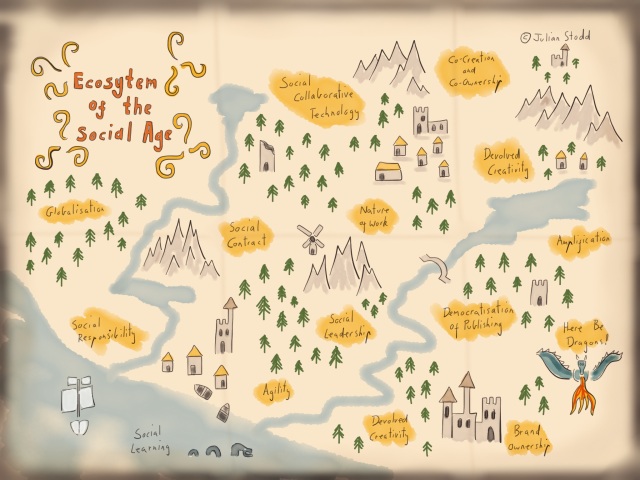I saw a video the other day of a small child discovering their shadow. They were walking along when they suddenly realised that the penumbra trailing close behind was somehow attached. A sequence of bemused hopping and dancing entailed as they tried to break free, before a realisation that it’s here to stay.
It’s like that with the Social Age: many organisations are aware that something is trailing them. Some are starting to shake a leg frantically, hoping it will drop off. A few are dancing in wonderment.
Sometimes people say to me, ‘Oh, social? Yes, we do that’, as if somehow i’m proposing that Twitter is their redemption.
The Social Age is not about Social Media. Sure, it’s facilitated by social technology and it’s certainly all about communities, but it’s much bigger and much deeper than that.
It’s a broad spectrum of change: the evolved nature of work, fractured social contract, evolved relationship with knowledge, greater diversity and need for equality, social responsibility, rise of social authority and, yes, collaborative technology. It’s about agility and devolved creativity. It’s mindset, sociology and technology in tandem, and it’s constantly iterating and changing.
The Social Age is an ecosystem, not a system to buy or learn. It’s an environment, a set of pressures, a mindset that we need to understand and navigate.
Take the democratisation of communication: it used to be about ‘broadcast‘, where organisations shaped messages and sent them out, down specific channels. Print, TV, in person. Reviewed, signed off and delivered. But no more. Communication is now layered and co-creative. Layered from formal through to fully social and covering messages that are co-owned by the community. In the Social Age, the story is co-written and out of the control of the organisation. This is a fundamental shift and will take more than technology to thrive within.
The rise of Social Authority, which fully subverts formal authority, is equally tectonic in nature and momentum. It’s a different type of engagement, a different way of being effective, a different way to lead. It’s not that the old ways are gone, we still need to master them, but the return that they give is diminished and, without the social authority, we cannot effectively lead.
The challenge with the Social Age is that the shadow is catching up: those that fail to recognise this and adapt to it will be subsumed by more agile and adaptable organisations.
How to adapt?
By creating spaces for experimentation. By prototyping and iterating both operating practices and behaviours. By providing rehearsal spaces. By ensuring that organisational infrastructure is facilitating, not controlling. By developing social leaders and learners. By adapting how we view learning. And collaboration. And competition. By engaging with our communities, both internal and external. By creating diverse ecosystems of technology. By relinquishing some elements of control in return for the benefits of co-creation.
And that’s just the start.
But by taking those first steps, the organisation is generating momentum, and all journeys start with that first step.





Reblogged this on juandon. Innovación y conocimiento.
Pingback: Chasing the Shadow of the Social Age | Curaci&o...
Reblogged this on Aila Comilang and commented:
A must read.
The lines that really resonated for me in all of this were “By creating spaces for experimentation. By prototyping and iterating both operating practices and behaviours. By providing rehearsal spaces.” I have a colleague who is a school principal in an arts based school and she talks about her leadership style as being “ensemble leadership”. I really am intrigued by the thought of rehearsal spaces in combination with ensemble leadership.
Love this post.
Thanks Maureen, yes, i think it reflects the more fluid nature of leadership in the Social Age. Spaces to learn and different ways to support each other. The first instinct of the Social Leader may be to set aside the mantle of leadership altogether. Thanks for sharing your reflections, best wishes, Julian
Pingback: This Week’s Links « Timothy Siburg
Pingback: The CEDA Community model Pt.1: ‘Curation’ and ‘Technology’ in Social Learning | Julian Stodd's Learning Blog
Pingback: Groundswell: waves of change | Julian Stodd's Learning Blog
Pingback: Chasing the Shadow of the Social Age | Homo Agi...
Pingback: 16 Resisters of Change | Julian Stodd's Learning Blog